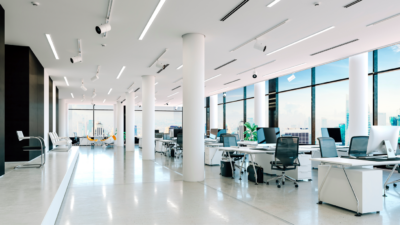In the first article of this two-part series, we outlined four specific attributes of the most innovative workplaces: purpose, flexibility, elasticity and technology/visualization, and explored purpose and flexibility in greater depth. Here, we’ll explore elasticity, technology and visualization and how these attributes enhance an office culture and environment.
Elasticity
How can an organization optimally design an office for a future they can’t predict? New technology, changing trends in work practices, aggregation of data, robotics and automation are all inevitable innovations, which raise questions about how to design an office around the uncertain future.
Elasticity is the ability of a workplace to adapt and change to the future as it arrives. This refers not only to physical space, but also how an office portfolio is managed. Elasticity is about breaking traditional workplace boundaries and barriers and innovating ahead of the curve. Traditional real estate best practices are changing to account for elasticity. More structural and financial bounds can be put in place, like buyouts, right of first refusals and shorter lease lengths.
Flexible workspaces and SPaaS (Space as a Service) have surged in popularity in recent years, especially with an evolving workforce that includes many freelancers and companies of all sizes and makeups with changing space needs. The benefits of these spaces include a highly curated design experience, sense of community and creative amenity spaces that are included in membership. This doesn’t mean traditional lease structures will become obsolete, but as the workforce and their space needs change, industry professionals should consider these strategies as a tool in any high-performing real estate portfolio management plan.
In terms of physical space, considering future change is critical to any workplace design decisions. Many companies are considering furniture-based solutions that are plug-n-play and demountable, whether they be full-height partitions, enclosed phone booths or table-based open collaborative settings with integrated technology. These elements can be shifted, relocated to another site or switched out for a new type of setting with a simple work order.
Configurability plays a large part in adapting environments for the purpose of user needs. Some companies go as far as establishing “carpet islands” with workstations, plenty of power access and other furniture items on wheels that allow users to reconfigure their workspace in real time and within the bounds of their team space. Regardless, a varied landscape of settings, within fixed and flexible zones, provides a framework for organizations to provide elasticity to their employees and teams as they grow and change.
Another aspect of elasticity is a more fluid use of space while in the office. Companies are seeing the benefits of low levels of desk sharing, neighborhood planning and plenty of multi-purpose work areas that allow spaces to be used for different tasks throughout the day. This model of sharing versus ownership accommodates shifting work modes by a greater number of people and more effective use of space, as well as providing autonomy and optimization of individual productivity to workers. In an economy where the cost of real estate will continue to rise, efficiency and effectiveness of space use will continue to be paramount to a company’s success.
Technology and Visualization
Automation is affecting every sector, even workplace design. Interactive, predictive technology is the form AI and automation are taking in the innovative office space. We’ve entered a time where anticipatory technology is at our fingertips and will continue to be integrated into the very fabric of our lives, which includes our workdays and workspaces.
It is now possible for the workplace to respond to individuals as they enter their offices. Many people already use smart home technology — and now we have smart offices. Smart technology can respond to an employee’s device or key fob and change the lighting or temperature based on that person’s needs and preferences.
Scheduling shared workspaces will become increasingly intuitive as predictive technology is able to sync employees’ calendars to find the right space for specific meetings using algorithms. Since amenities will be used on demand, for the highest and best use, efficiency of space utilization will become more manageable than ever before.
The workplace is becoming an interactive partner and productivity tool, rather than technology that workers must learn to navigate. These interactive environments will help workers be more efficient, rather than acting as a constraint. As offices adapt to continued intergenerational differences and needs, technology can help to mitigate the challenges (and benefits) that come from a wide generational swath.
Technology and data visualization can also serve to inspire by translating information into digestible form. Some companies are partnering with data teams and experiential designers to create meaningful and unique digital visualizations that change with the data and engaging employees by bringing them closer to positive customer experiences.
Innovative technology can enhance office culture and add value to the employee experience by increasing productivity, reducing friction in the workplace and enhancing expression through inspiring animations, all powered by cyber-physical systems. And one thing is certain, as technologies and workplaces evolve, innovation will continue to be an essential element in attracting and retaining top talent.
About the Author
Michelle Cleverdon leads the western region on behalf of the Colliers’ Workplace Consulting team. With a passion for developing transformational strategies, she is focused on the meaningful connection between people, technology and the work environment.
Contributors
Keith leads the Workplace Consulting practice for Colliers International in the Americas. His team helps create environments that engage employees, drive culture, promote wellness and enable productivity leading to competitive advantage.
Kate is a senior leader within the Workplace Consulting practice at Colliers International and is a globally recognized thought-leader, speaker and author. With over 25 years of experience, Kate believes in “the power of place” and has witnessed “what’s possible” when the workplace is aligned with an organization’s culture and business goals.

 Michelle Cleverdon
Michelle Cleverdon Michelle Cleverdon
Michelle Cleverdon Keith Perske
Keith Perske Kate North
Kate North
 Marianne Skorupski
Marianne Skorupski Michael Lirtzman
Michael Lirtzman Kevin Gonzalez
Kevin Gonzalez Kim Kendall
Kim Kendall Ashley Harrison
Ashley Harrison
 Charles Dilks
Charles Dilks Matthew Johnston
Matthew Johnston Victoria Abbasi
Victoria Abbasi
 Derek Daniels
Derek Daniels Franklin Wallach
Franklin Wallach